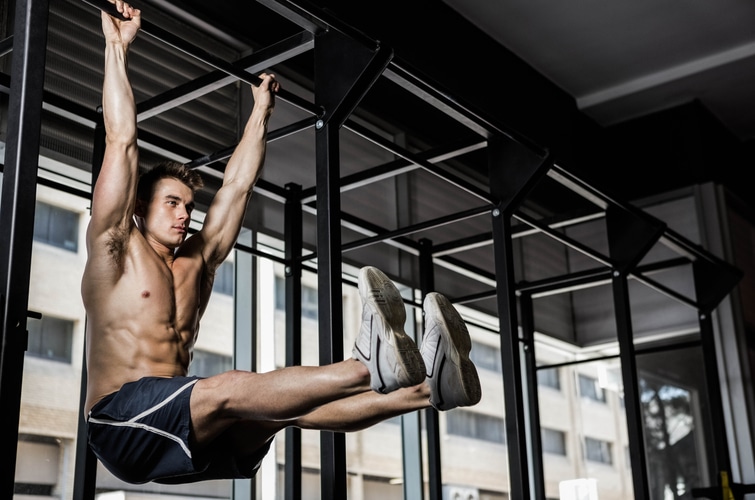The push-up and pull-up are great exercises you can do anywhere. But which one is better for you? The answer to this question depends on your goals, fitness level, and strength.
Both exercises target different groups of muscles in the same general area. Both also require strength and stamina to perform correctly. Which one is better for you may come from personal preference and specific needs.
A push-up vs. pull-up comparison will help you determine which exercise is proper for you. Let's take a closer look at each workout to find out.
Contents
Push-Up vs. Pull-Up: What's The Difference Between The Two Exercises?
The main difference between a push-up and a pull-up is the position of your body. In a push-up, you start in a plank position with your hands on the ground and your feet shoulder-width apart. You then lower your body to the floor, keeping your core engaged the entire time.
In a pull-up, you start by gripping a Pull-Up bar with your palms facing away from you. You then pull your body up until your chin is over the bar. To lower yourself back down, reverse the motion.
Both body weight exercises work for different muscle groups and target other body areas. But they both require a similar amount of strength and stamina to perform.

How To Do Push-Up and Pull-Up?
Doing both entire body weight exercises needs some practice. But they are both relatively easy to do once you get the hang of it.
How To Do a Push-Up?
Start in a plank position with your hands on the ground and your feet shoulder-width apart. Lower your body down to the floor, keeping your core engaged the entire time. Once your chest touches the ground, push back to the starting position. That's one rep.
You can do it with your knees on the ground to make it easier, or you can put your feet up on a chair or elevated surface to make it harder.
Perform Pull-ups by Using a Pull-up Bar
Start by gripping a Pull-Up bar with your palms facing away from you in performing pull-ups. Pull your body up until your chin is over the bar. To lower yourself back down, reverse the motion.
You can make it easier by using a resistance band or holding onto something else with your feet to take some weight off your arms. Or you can make it more challenging by adding weight to your body with a weight belt or vest.
Different Types of Push-Ups
There are many different types of push-ups that you can do to target other muscle groups. Here are some of the most popular:
Standard Push-Up
This is the most common type. It works your chest, shoulders, triceps, and core. A standard push-up is a great all-around exercise to add to your workout routine.
Wide Push-Up
This type targets your chest muscles more than a standard push-up. To do a wide push-up, place your hands wider than shoulder-width apart when you start in the plank position.
Close Push-Up
A close push-up is the opposite of a wide push-up. It targets your triceps more than your chest. To do it, place your hands closer than shoulder-width apart when you start in the plank position.
Diamond Push-Up
A diamond push-up is similar to a close push-up but targets your triceps even more. To do a diamond push-up, place your hands together in the shape of a diamond when you start in the plank position.
Narrow Push-Up
A narrow push-up is similar to a close push-up but targets your inner chest more. To do a little push-up, place your hands close together and slightly inward when you start in the plank position.

What Are the Muscles Push-Ups Work?
Push-ups work your chest, shoulders, triceps, and core. The primary muscle group worked is your pectoralis major, the large muscle in your chest.
Your triceps, deltoids, and latissimus dorsi also get a good workout with push-ups. And because you have to keep your core engaged the entire time, your abs and lower back also get some love.
Take note of these major muscles the next time you do a push-up, and you will feel the burn:
2 Types of Pull-Ups
There are two main types of pull-ups and numerous variations. Tactical and bodybuilding are the two primary types. Remember to grip the bar with your palms facing you when doing pull-ups. A chin-up is a different workout if you hold the bar with your palms facing you. Pull-ups and chin-ups each work for the very same muscle groups.
Tactical Pull-Ups
Tactical pull-ups are a type of pull-up that is performed with a false or supinated grip. In this grip, your palms are facing away from you when you grip the bar. It would help if you wrap your thumbs around the bar, and your pinkies should be on top of the bar. It is a shoulder-width grip.
Bodybuilding Pull-Ups
The second primary type is bodybuilding pull-ups. These are performed with an underhand or pronated grip. Your palms are facing toward you when you grip the bar. It is a shoulder-width grip as well.
Both types of pull-ups work for the same muscle groups, but they target them differently. Tactical pull-ups focus more on the biceps, while bodybuilding pull-ups focus more on the latissimus dorsi.
What Are the Muscles Pull-Up Work?
Pull-ups help to strengthen the muscles in your upper arms and back. Pull-ups also aid in the development of a firm grip with your hands. Awareness of which muscles work and how they work enables you to see what your body should do.
Pull-ups engage the following back muscles:
-
The latissimus dorsi muscle is also widely recognized as the lats. The lats are the large flat muscle that runs from your tailbone to under your arms in a triangle shape.
-
The trapezius muscles: Such muscles run in an arrowhead pattern from the base of your skull down the neck across the shoulders and end halfway down your back. It crosses over the latissimus dorsi muscle.
-
Pull-ups work the teres significant muscles along the shoulder blades as well.
-
The posterior deltoid rhomboids wrap around the shoulder joint and into the upper arms from beneath the trapezius muscle.
-
Rotator cuff muscles are located beneath the deltoid rhomboids.

Pull-Up vs. Push-Up: What Are the Benefits For You?
Both exercises have a lot of benefits. They both build strength and muscle, and they both improve your posture. But there are some specific benefits to each workout.
Whether you do a push-up or a pull-up, you can get a great workout. But if you are looking for specific benefits, here's what each exercise has to offer:
The Benefits of Push-Up
Here are some benefits of doing push-ups as part of your workout routine.
1 - Improves Posture
Poor posture can lead to back pain and other health problems. But doing push-ups can help improve your posture. That's because they strengthen the muscles in your chest and shoulders, which helps to pull your shoulders back and improve your posture.
2 - Tones the Chest, Shoulders, Arms, and Core
Push-ups are a great way to tone all your upper body muscles. They will help you build strong, toned muscles in your chest, shoulders, arms, and core.
3 - Can be Done Anywhere, Anytime
One of the best things about push-ups is that they can be done anywhere. You don't need any equipment or a gym membership. Just find a flat surface, and you are good to go.
4 - Improves Flexibility
A regular push-up routine can improve your flexibility. That's because it stretches and lengthens your muscles. Flexibility is essential for overall health and can help prevent injuries.
5 - Improves Balance and Coordination
Push-ups require balance and coordination. As you get stronger, you'll be able to do more push-ups with better form. It will help improve your balance and coordination.
6 - Improves Sports Performance
If you are an athlete, push-ups can help improve your sports performance. They'll help build the muscles and strength you need to excel in your sport.
7 - Burns Calories
Push-ups are a great way to burn calories and lose weight. They will help you torch calories and tone your muscles simultaneously. Your calories burned will depend on your weight, intensity, and how many push-ups you do.
8 - Builds Upper Body Strength
Push-ups are a great way to build strength in your upper body. They work your chest, shoulders, arms, and core. And the more you do them, the stronger you will get.
As you can see, push-ups offer a lot of benefits. They're a great way to build strength, improve posture, and tone muscles. And they can be done anywhere, anytime. So if you're looking for a great workout, add some push-ups to your routine.

The Benefits of Pull-Ups
The same as push-ups, pull-ups also give benefits to your health. Some of its benefits are:
1 - Strengthens the back muscles
Pull-ups are a great way to strengthen your back muscles. They work the latissimus dorsi, the large muscle in your back. And the stronger your back muscles are, the better your posture will be.
2 - Improves posture
Pull-ups can also help improve your posture. That's because they strengthen the muscles in your back and shoulders, which helps to pull your shoulders back and improve your posture.
3 - Builds upper body strength
Pull-ups are a great way to build upper body strength. They work your back, shoulders, arms, and core. And the more you do them, the stronger you'll get.
4 - Tones the back, shoulders, arms, and core
Pull-ups are a great way to tone all the muscles in your upper body. They'll help you build strong, toned back, shoulders, arms, and core muscles.
5 - Improves grip strength
Pull-ups also help to improve your grip strength. That's because you must hold on to the bar for the entire exercise. And the more robust your grip is, the better you'll be able to do other activities like chin-ups and rows.
6 - Mental health benefits
Pull-ups can also have some mental health benefits. That's because they require focus and concentration. And doing them can help to improve your mental clarity and focus.
7 - Physical health benefits
Pull-ups also have some physical health benefits. They can help to improve your cardiovascular health and reduce your risk of injuries.
Pull-ups are an excellent exercise to improve your posture, strengthen your back muscles, or build upper body strength.
Perform Pull-ups and Push-ups:
Do They Help You Lose Weight?
Yes, both exercises will help you lose weight. They will help you burn calories and build muscle. The more muscle you have, the more calories you'll burn.
Push-ups impact your weight-loss journey by:
-
Working for multiple muscle groups at once. It helps to increase the number of calories you burn in a workout.
-
Building muscle. The more muscle/strength you have, the more calories you'll burn at rest.
-
Increasing your metabolism. Push-ups help improve your metabolism, which means you'll burn more calories daily.
-
Helping you to stay motivated. Doing push-ups can help you stay motivated on your weight-loss journey. They'll give you a sense of accomplishment and help you see results.
Pull-ups have all of the same benefits as push-ups regarding weight loss. They will help you burn calories, build muscle, and increase your metabolism. And it even helps you stay motivated on your journey.

How Many Push-Ups and Pull-Ups Should I Do To Lose Weight?
The number of push-ups and pull-ups you need to do to lose weight will depend on your goals. If you're just looking to tone your muscles, then a few sets of each exercise will suffice. But if you're looking to lose weight, you'll need to do more.
To lose weight, you need to create a calorie deficit. That means you need to burn more calories than you consume. And the best way to do that is by exercising and eating healthy foods. So if you want to lose weight, make sure you're doing both push-ups and pull-ups regularly. And eat a healthy diet.
The Final Thoughts
So there you have it, comparing the two exercises: push-up vs. pull-up. Both movements are great for you and have a lot of benefits. But ultimately, it comes down to which exercise you prefer and which works better for your goals.
So try out both exercises and see which one you like best. And then, make sure to include it in your workout routine regularly.






